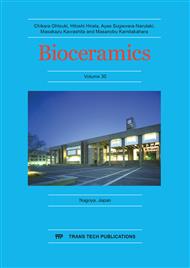[1]
Mundy, G., Garrett, R., Harris, S., Chan, J., Chen, D., Rossini, G., B. Boyce, M. Zhao, Gutierrez, G. L., Stimulation of bone formation in vitro and in rodents by statins. Science, 286 (1999) 1946-(1949).
DOI: 10.1126/science.286.5446.1946
Google Scholar
[2]
Naito, Y., Terukina, T., Galli, S., Kozai, Y., Vandeweghe, S., Tagami, T., Ozeki. T., Ichikawa T., Paulo G. Coelho, Jimbo, R., The effect of simvastatin-loaded polymeric microspheres in a critical size bone defect in the rabbit calvaria. Int. J. pharm. 461(1-2), (2014).
DOI: 10.1016/j.ijpharm.2013.11.046
Google Scholar
[3]
I Ito, T., Takemasa, M., Makino, K., Otsuka, M., Preparation of calcium phosphate nanocapsules including simvastatin/deoxycholic acid assembly, and their therapeutic effect in osteoporosis model mice. J. Pharmacy and Pharmacology, 65(4) (2013).
DOI: 10.1111/jphp.12008
Google Scholar
[4]
Xia, Z., Huang, Y., Adamopoulos, I. E., Walpole, A., Triffitt, J. T., Cui, Z., Macrophage‐mediated biodegradation of poly (DL‐lactide‐co‐glycolide) in vitro. J. Biomedical Materials Res. Part A: An Official Journal of The Society for Biomaterials, The Japanese Society for Biomaterials, and The Australian Society for Biomaterials and the Korean Society for Biomaterials, 79(3) (2006).
DOI: 10.1002/jbm.a.30853
Google Scholar
[5]
Anderson, J. M., Shive, M. S., Biodegradation and biocompatibility of PLA and PLGA microspheres. Advanced drug delivery reviews, 28(1) (1997) 5-24.
DOI: 10.1016/s0169-409x(97)00048-3
Google Scholar
[6]
Liu, H., Slamovich, E. B., Webster, T. J., Less harmful acidic degradation of poly (lactic-co-glycolic acid) bone tissue engineering scaffolds through titania nanoparticle addition. Int. J. nanomedicine, 1(4) (2006) 541.
DOI: 10.2147/nano.2006.1.4.541
Google Scholar
[7]
Terukina, T., Saito, H., Tomita, Y., Hattori, Y., Otsuka, M., Development and effect of a sustainable and controllable simvastatin-releasing device based on PLGA microspheres/carbonate apatite cement composite: In vitro evaluation for use as a drug delivery system from bone-like biomaterial. J. Drug Delivery Science and Technology, 37 (2017).
DOI: 10.1016/j.jddst.2016.10.007
Google Scholar
[8]
Ohtsuki, C., Kamitakahara, M., Miyazaki, T., Coating bone‐like apatite onto organic substrates using solutions mimicking body fluid. J. tissue engineering and regenerative medicine, 1(1), (2007) 33-38.
DOI: 10.1002/term.3
Google Scholar
[9]
Otsuka, M., Hirano, R., Bone cell activity responsive drug release from biodegradable apatite/collagen nano-composite cements—In vitro dissolution medium responsive vitamin K2 release. Colloids and Surfaces B: Biointerfaces, 85(2) (2011) 338-342.
DOI: 10.1016/j.colsurfb.2011.03.006
Google Scholar


